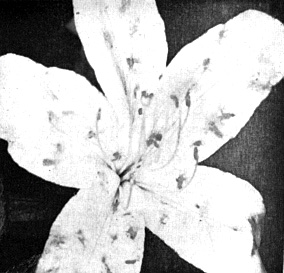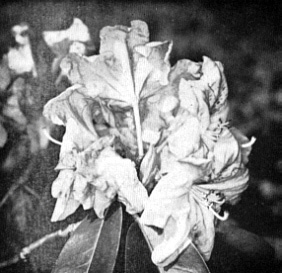QBARS - v15n1 Azalea Petal Blight Is In The Philadelphia Area
Azalea Petal Blight is In the Philadelphia Area
Patricia Allison
Spring is sometimes slow in coming to Philadelphia. Early crocus gladdens the heart, to be sure, but there is never a rush to put woolens away. Nor does the fragrance of narcissus always tempt a Philadelphian to store a snow shovel. Tantalize as it may, Spring is virtually certain when the azaleas finally begin their splurge. Suddenly Philadelphia vies with Natchez, or Charleston, or New Orleans, as the splendid spectrum of azaleas illuminates May and rhododendrons usher in June.
Even a newcomer can note, however, that one year's display may far outshine another. The azalea bloom at the Arboretum in 1958 was far superior to that of 1959, for example. Last year the colors seemed dim, the season short. This year we know why. The same fungus that in the past transformed the world-famous azalea blossoms of Charleston, South Carolina, into slimy mush in a matter of hours is now active in Philadelphia. Its name is Ovulinia azaleae Weiss; the disease is "flower spot" or "petal blight."
History and Distribution
The gardens of Charleston, in 1931, were the scenes of the first noted outbreak. Within seven years other plantings were affected along the Gulf Coast to Texas and up the Atlantic seaboard to North Carolina. These are areas that attract azalea lovers from all parts of the nation. By 1947 the fungus was known in Virginia, Maryland, and California. Until recently its northernmost limit was thought to be Washington, D.C. Then came news in 1956 that greenhouse crops on Long Island were diseased. Now we know that Philadelphia is within the range of the fungus for outdoor plantings, and, judging from the widespread occurrence of the disease this year, the pathogen has been here for some time.
The Pathogen
It was mentioned that the display of bloom in 1959 was less spectacular than in 1958. This was thought to be a normal seasonal variation, and the possibility of petal blight never was considered until midsummer when definite evidence of the pathogen was encountered. This consisted of tiny, black, cup shaped fungus structures, called sclerotia, found on flowers that had not fallen from the shrubs. Dr. Freeman Weiss first described and named the pathogen. He discovered that the sclerotia would remain alive over winter on the ground, and that the environmental conditions prevailing in early spring permitted the development of the next stage in the life cycle of the pathogen. This is a tiny, fleshy fruiting body, the apothecial stage, from which spores are shot into the air. Some of them land on the low-hanging flowers of early-blooming varieties; others are wafted by breezes or rain to additional blossoms. The spores germinate on the surface of the petals and the germ tubes invade the tender tissue from which food is obtained. A little later a second type of spore (conidium) is formed by the thousands on the surfaces of the petals. Under slight magnification these can be seen glistening in whitish patches or silhouetted at the edges of petals. Higher magnification is needed to see that each single-celled spore has a tiny suspensor cell attached to it. Other fungus structures develop at about the same time, but their exact role in the life cycle has not been discovered. Crop after crop of conidia is formed during the flowering period. These spores are carried to other flowers by wind, rain, and even insects. Only after the blossom is well rotted do the sclerotia begin to appear. At first they are whitish curved mats. Later they turn dark, and may fall out of the petal tissue to the ground. As far as is known, the fungus attacks only the blossoms. Despite this fastidious attachment for flowers, the host range among varieties of azalea and rhododendron is broad, and even kalmia blooms are occasionally damaged.

|

|
|
Fig. 8. Flowers of
R. mucronulatum
with
early stages of petal blight. |
Fig. 9. Petal collapse beginning on
R.
obtusum . |
Symptoms
After the microscopic spore starts the cycle, growth of the minute sporling in petal tissue results in a small spot. On white flowers, the spots are brownish (Fig. 8). On colored petals they are paler than the surrounding tissue. If weather permits, the continued growth of the fungus causes rapid destruction of the petals. The flowers sag and turn brown, plastering the leaves, transforming the shrub into an unsightly mess. Dr. Cynthia Westcott, who pioneered in the development of chemical control methods, describes the appearance well, saying that the bushes look as if they had boiling water poured over them. If the atmosphere remains moist, the petals are distinctly slimy. Even petals that are only half destroyed fall apart at the touch. This is an important diagnostic characteristic. Another is the fact that brown areas may still retain a trace of the original small spot. Still another, is the fact that dead flowers often remain on the shrub, some still attached to the flower stalk, others plastered on the foliage. Symptoms on rhododendrons are similar (Fig. 9).
Control
The fact that Ovulinia azaleae causes frequent devastation in southern gardens and is now in the Philadelphia area should not lead us immediately to the conclusion that we must at once begin the same sort of extensive control program recommended for the South. There is the distinct possibility that the fungus is indeed near the northern limit of its range and that we can therefore expect serious trouble only infrequently.
For a time, until we know more about the particular symptomology in the Philadelphia area, it will be wise to view all supposed examples of "frost damage," "scorch," and the like with suspicion. Early season marginal browning can very well be caused by the fungus, and the stage may then be set for major collapse of bloom at peak season. Such was the case this year.
Should the experience of this spring prove to be the rule rather than the exception, azalea growers in the Philadelphia area can be both forewarned, through knowledge of symptoms, and forearmed in a very real sense with the knowledge about chemical and cultural control methods supplied us by researchers working in the South and by industries already supplying materials for use in controlling this disease in that area.
There are now two chemical approaches to the control of petal blight. One is the application of large doses of fungicide to the ground below the shrubs when they are dormant. This, of course, is to destroy the pathogen before the spring spore ejection begins. The technique was not successful until the recent development of special compounds. Now it may very well prove to be the most important single application of the season.
The second approach has been to protect the flowers themselves throughout the bloom period. Spectacular control has been obtained with the use of Zineb and Actidione-RZ. The latter material is now recommended for ground spray also. There is some indication that it may replace Zineb as the treatment of choice.
In the south, floral spraying is begun when the early varieties are in bloom. Sprays are applied three times a week for about a month. I know of no other control technique in which the method of application is so important. Unless the spray itself is exceedingly fine, any of the chemicals that could control the fungus in near-miraculous fashion may actually damage the bloom and new foliage.
The compounds must be applied as a fine mist--nearly a fog--and wafted toward the blooms from several directions.
It is hoped that such an extensive program will never be necessary in the Philadelphia region.
At present we are suggesting that Philadelphians familiarize themselves with the symptoms of petal blight as much as possible. This should definitely include examination of their own shrubs now. Flowers that are still clinging to shrubs should be inspected for sclerotia, then burned. If the fungus is found, the owner should consider using a ground spray of Actidione-RZ next year. We plan to use this treatment in some beds where the disease was severe this spring.
Remove any dead or diseased bloom from new shrubs next year before bringing them to your garden. Petal blight of both azaleas and rhododendrons was common on plants for sale in various garden centers this year. There is little doubt that the fungus was shipped to us from the South with nursery stock. Even if your garden is not free of it, there is little sense in increasing the population still more.
Rejoice in the knowledge that the results of nearly 30 years of study and research in the South are available to you should the disease prove increasingly destructive in Philadelphia.
